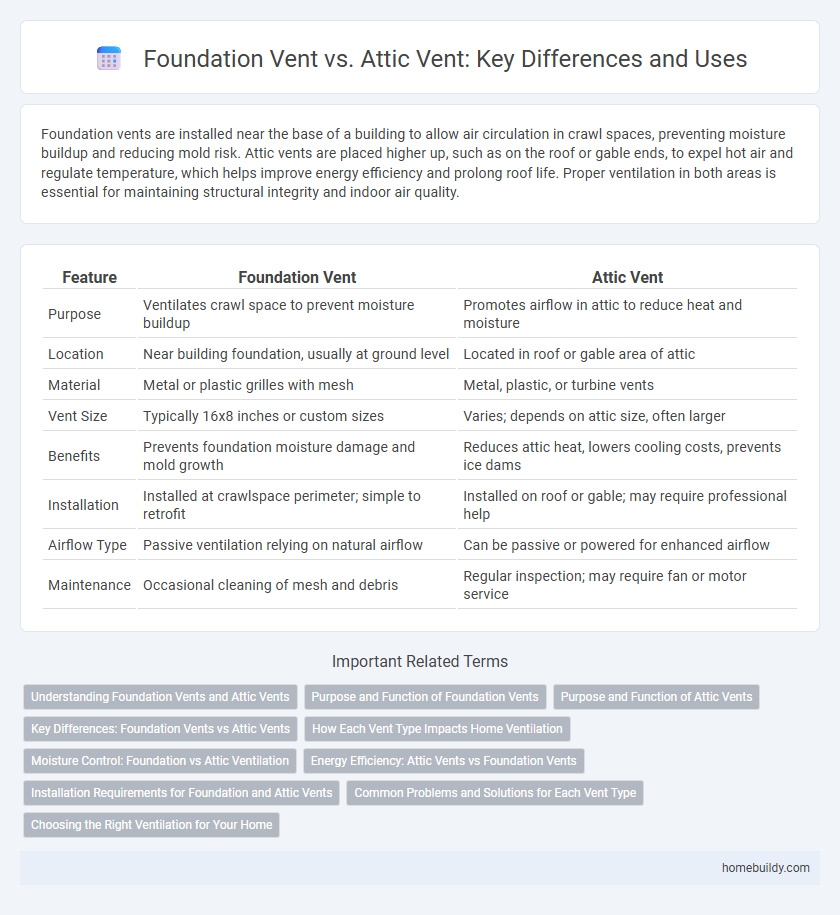Foundation vents are installed near the base of a building to allow air circulation in crawl spaces, preventing moisture buildup and reducing mold risk. Attic vents are placed higher up, such as on the roof or gable ends, to expel hot air and regulate temperature, which helps improve energy efficiency and prolong roof life. Proper ventilation in both areas is essential for maintaining structural integrity and indoor air quality.
Table of Comparison
| Feature | Foundation Vent | Attic Vent |
|---|---|---|
| Purpose | Ventilates crawl space to prevent moisture buildup | Promotes airflow in attic to reduce heat and moisture |
| Location | Near building foundation, usually at ground level | Located in roof or gable area of attic |
| Material | Metal or plastic grilles with mesh | Metal, plastic, or turbine vents |
| Vent Size | Typically 16x8 inches or custom sizes | Varies; depends on attic size, often larger |
| Benefits | Prevents foundation moisture damage and mold growth | Reduces attic heat, lowers cooling costs, prevents ice dams |
| Installation | Installed at crawlspace perimeter; simple to retrofit | Installed on roof or gable; may require professional help |
| Airflow Type | Passive ventilation relying on natural airflow | Can be passive or powered for enhanced airflow |
| Maintenance | Occasional cleaning of mesh and debris | Regular inspection; may require fan or motor service |
Understanding Foundation Vents and Attic Vents
Foundation vents and attic vents serve distinct purposes in home ventilation systems, crucial for maintaining structural integrity and indoor air quality. Foundation vents allow air circulation in crawl spaces or basements, preventing moisture buildup and reducing mold growth, while attic vents facilitate airflow in the attic to regulate temperature and moisture levels, extending roof lifespan. Proper placement and sizing of both vents are essential for optimal ventilation and energy efficiency.
Purpose and Function of Foundation Vents
Foundation vents primarily serve to promote air circulation in crawl spaces, preventing moisture buildup that can lead to mold, wood rot, and structural damage. Unlike attic vents that regulate temperature and moisture in the attic, foundation vents focus on maintaining dry conditions beneath the building. Effective foundation ventilation helps preserve the integrity of the foundation by reducing humidity levels and minimizing the risk of pest infestations.
Purpose and Function of Attic Vents
Attic vents facilitate airflow to regulate temperature and moisture levels, preventing heat buildup and condensation that could damage roofing materials and reduce energy efficiency. These vents work by allowing hot air to escape in the summer and minimizing moisture accumulation in colder months, which helps in preserving structural integrity. Proper attic ventilation also supports HVAC system performance by reducing strain and maintaining consistent indoor temperatures.
Key Differences: Foundation Vents vs Attic Vents
Foundation vents are installed at the base of a building's foundation to allow air circulation in crawl spaces, preventing moisture buildup and mold growth. Attic vents, located near the roofline, facilitate heat and moisture escape from the attic, improving energy efficiency and prolonging roof life. The key difference lies in their placement and function: foundation vents manage ground-level moisture, while attic vents control upper-level temperature and humidity.
How Each Vent Type Impacts Home Ventilation
Foundation vents promote airflow in crawl spaces, reducing moisture buildup and preventing mold growth, which helps maintain structural integrity. Attic vents facilitate the exchange of hot, humid air with cooler outside air, improving temperature regulation and lowering cooling costs. Both vent types are crucial for balanced home ventilation, but foundation vents target below-floor moisture control while attic vents focus on upper-level heat dissipation.
Moisture Control: Foundation vs Attic Ventilation
Foundation vents promote moisture control by allowing air to circulate beneath the structure, preventing dampness and mold growth in crawl spaces. Attic vents regulate temperature and humidity in the attic, reducing condensation that can damage roofing materials and insulation. Effective ventilation in both foundation and attic areas is essential for maintaining overall home durability and indoor air quality.
Energy Efficiency: Attic Vents vs Foundation Vents
Attic vents improve energy efficiency by allowing hot air to escape, reducing cooling costs and preventing moisture buildup in the roof structure. Foundation vents promote airflow in crawl spaces, minimizing humidity and preventing mold, which indirectly contributes to energy savings by maintaining insulation effectiveness. Properly balanced attic and foundation ventilation optimize overall building performance and reduce HVAC system strain.
Installation Requirements for Foundation and Attic Vents
Foundation vents require placement near the ground level with proper clearances from soil and debris to ensure adequate airflow and moisture control. Attic vents must be installed high in the roof or gable walls, maintaining specific distances from roof edges and insulation to optimize ventilation and prevent heat buildup. Both vent types demand compliance with local building codes and manufacturer specifications for size, spacing, and materials to achieve effective ventilation performance.
Common Problems and Solutions for Each Vent Type
Foundation vents often face issues with moisture buildup and pest infiltration, which can lead to mold growth and structural damage; installing mesh screens and using vapor barriers helps mitigate these problems. Attic vents commonly suffer from inadequate airflow and insulation blockages, resulting in heat retention and ice dams; ensuring proper vent spacing and using baffles improves ventilation efficiency. Regular maintenance and moisture control are essential solutions for both foundation and attic vents to maintain optimal home ventilation and prevent costly repairs.
Choosing the Right Ventilation for Your Home
Foundation vents promote crawl space airflow, reducing moisture buildup and preventing mold growth, while attic vents facilitate heat and moisture escape from the attic, improving roof longevity. Selecting the right ventilation depends on your home's specific needs, climate conditions, and structural design to ensure optimal air circulation and energy efficiency. Properly balancing foundation and attic vents enhances indoor air quality and protects your home from potential deterioration.
Foundation vent vs Attic vent Infographic

 homebuildy.com
homebuildy.com